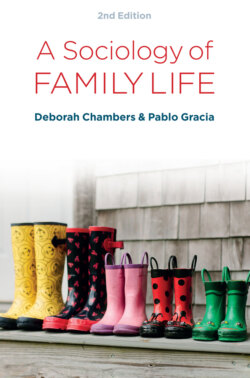Читать книгу A Sociology of Family Life - Deborah Chambers - Страница 18
Conclusions
ОглавлениеThis chapter has shown how the roots of certain enduring ideas about the family, which remain with us today, lie within the work of classical thinkers. It demonstrates how late nineteenth-century and early twentieth-century sociological theories about the family contributed to or sustained biological and social discourses, often drawing on quite contradictory frameworks of thinking. On the one hand, the family was assumed to be a universal biological unit. On the other hand, sociologists were preoccupied with the effects of social and economic change on family structures. Although the family was mainly viewed through a biological lens, it was a lens used selectively to authenticate and legitimate an approved, monogamous, patriarchal and nuclear version sanctioned by a companionate partnership.
A second area of concern among sociologists was the effects of industrialization and urbanization on family structures, and the desire to elevate a recent, nuclear model as the norm. A major and continuing fear among both academics and governments was the nuclear family’s state of decline caused by encroaching individualism and privatization. The ideal companionate marriage was promoted to strengthen modern conjugal relationships in response to this fear of a decline in both the family and traditional communities. Based on positive intimate relationships between partners, this new kind of marriage was viewed as proof that the ‘modern marriage’ was becoming more egalitarian. By narrowly defining a small, mobile nuclear family as universal, functionalism treated all other family types as deviations from this family form.
Dramatic changes in family structures across the twentieth century revealed that the nuclear family was neither universal nor permanent. Parsons did not predict the dramatic rise in divorce rates by the end of the twentieth century. In the USA, the number of households with two parents and children declined by 20% between the 1960s and 1990s (Casper and Bianchi 2002:11 and 99). And in 1950, 93% of children in the US lived in a nuclear family, while only 6% lived with only their mother and 1% with only their father. By 1998, 73% lived in a nuclear family, 22% with only their mother and 5% with only their father (Casper and Bianchi 2002:99). Similar changes occurred in Europe. More recently, for example, 66% of children in Denmark aged 11–15 were not living with two parents by 2006, while in France it was 73%, in Hungary it was 74%, in Ireland it was 81%, and in Spain 84% (Lappegard 2017). Similar demographic transformations occurred transnationally (for example in Europe, Latin America, North America and Southeast Asia), with higher births outside marriage, increasing rates of cohabitation, and rising divorce rates occurring until the first decade of the twenty-first century (Lesthaeghe 2010). This demographic trend diverges from the mid-twentieth-century vision of the family promoted by structural functionalism.
These trends indicate that social attitudes and behaviour changed dramatically during the twentieth century and beyond. However, certain traditional family values and norms endure. This is illustrated in the next chapter which engages with recent research that demonstrates the importance of continuity and connectedness among family members. One of the major distinctions between traditional and more recent approaches to families, households and individuals is the shift away from the idea of ‘the family’ as a social institution governed by rigid moral conventions towards an idea of family and wider personal life as diverse and fluid sets of social customs and practices. The following chapters indicate that the focus today, in sociological debates, is on interactive processes and the agency of individuals and family members in relation to the social constraints of gender, sexuality, generation, social class, race, ethnicity and migration.
